
Nissan Patrol and Toyota LandCruiser have been fierce rivals since both Japanese brands started building their own ‘Jeeps’ in the second half of the 1950s. Now, as they both mark 70 years of their respective nameplates, Toyota has graced us with an all-new LandCruiser in the form of the 300 Series – the first new Cruiser in more than 14 years.
It’s only fitting then that we pitch it up against its traditional foe in the current model Y62 Nissan Patrol. While the Cruiser might be new, the Patrol is more than 10 years old now and even though there has been a few facelifts and upgrades over that time, it’s still essentially the same package – and that’s a good thing.
What we have here is the top of the range Nissan Patrol Ti-L which sells for $93,365 and lines up against the similarly specified LandCruiser Sahara at $130,190. The Sahara used to be the top-spec model in the Cruiser range but now there are both the GR Sport and the Sahara ZX model above it topping out at $138,790.
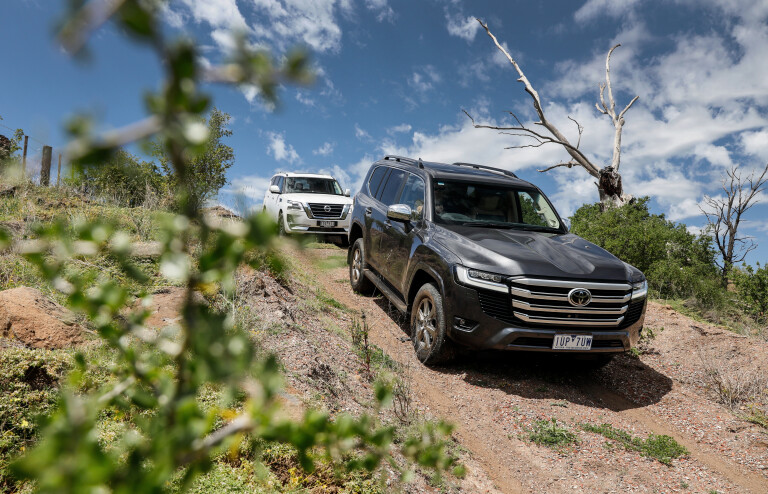
LANDCRUISER 300 SAHARA
POWERTRAIN & PERFORMANCE
All LandCruiser 300s are powered by a 3.3-litre twin-turbo V6 diesel engine that makes 700Nm of torque and 227kW of power, so it has higher outputs than the old V8 diesel engine.
An interesting thing about the design of this engine is that it is a ‘Hot-V’ design. This means that the exhaust manifolds and the turbochargers are mounted in the V between the cylinder heads and the intake manifolds are on the outside of the engine. This helps to make the engine more compact and puts the turbochargers closer to the exhausts ports to reduce lag.

With all that heat now at the top of the engine, Toyota has had to do away with the top-mounted intercooler as used on previous LandCruisers and moved them up behind the grilles under the headlights. I say them, as there are two of them and they are now fluid-to-air design so they should be more efficient. Anyone travelling in regional areas will want a decent bullbar to protect the coolers from frontal impact. More often than not, it’s the corners of the front bumper that cop a ’roo and that’s exactly where the intercoolers are mounted, just like in the new Defender.
The 90-degree V6 engine is a smooth and torquey performer that feels to get on with the job much more swiftly than the old 1VD V8. It’s quiet and punchy and works seamlessly with the new 10-speed automatic, which is the only transmission offered in the 300. Previous testing has shown it to be a capable towing powertrain with a 3000kg dual-axle trailer hitched behind the Cruiser.
ON ROAD RIDE & HANDLING
THE LC300 retains the same suspension format from previous LandCruiser models of an IFS and live rear axle, both riding on coil springs, but it has been heavily revised. There’s no fancy height adjustment or trickery to it, however the Sahara does have variable dampeners for comfort and sport settings.
In the traditional LandCruiser way, the suspension is soft and supple to deliver a smooth and comfortable ride, but it gets a bit wild and wallowy when pushed hard on tight roads or tracks. The sport setting on the dampeners does address this a bit, but it’s never as composed as the Patrol on such roads.
OFF ROAD
IT wouldn’t be a LandCruiser if it didn’t excel off road and the LC300 has again raised the bar in this regard. Specifically in its electronics with the best calibrated traction control system we have ever driven. The L663 Defender has held that honour for the last 12 months or so but the LC3 has taken the title.
Once again, we were impressed by the calibration and fast-acting nature of the electronic traction control (ETC) and amazed by how smoothly and effectively the Crawl Control system operates.
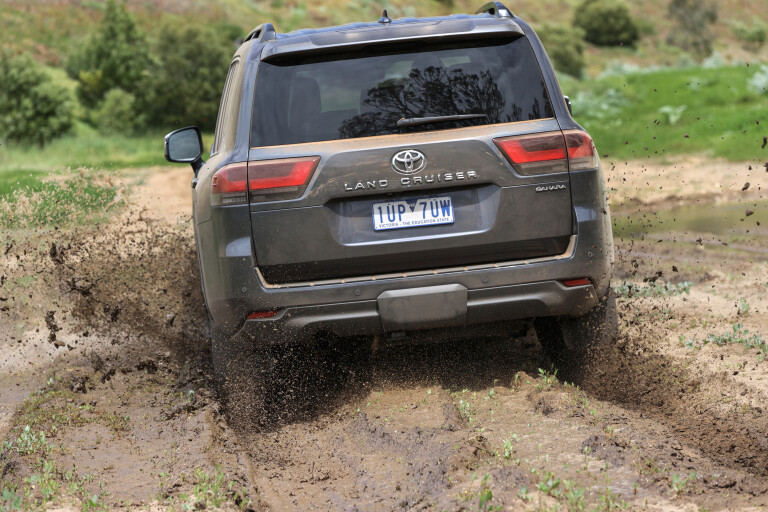
The Cruiser smoothly and effortlessly crawled its way up our rutted hill climb on this test and has surprised us on some rocky climbs in other recent tests. Only the centre differential is lockable, as the Sahara relies on its electronics and has pretty good wheel travel.
Only the GR Sport LC300 model is available with factory front and rear lockers.
CABIN & ACCOMMODATION
THE inside of the 300 instantly feels like a LandCruiser so LC200 owners should be comfortable in there. It’s big and plush and should be perfectly suitable for long road trips with the family. The new dashboard has a massive configurable AV screen and the system now includes CarPlay and Android auto.
The centre stack is busy with buttons and they take a bit of getting familiar with. We found that in some light the silver buttons glare back in to the drivers or passengers face when you look at them.
The lower seating position in the 300 compared to the 200 is appreciated by taller folks, as it puts the driver in a better position and gives a better view of the surroundings through a lower window-line. Of course the seat can be raised if needed and the steering column is power adjustable for both reach and height.
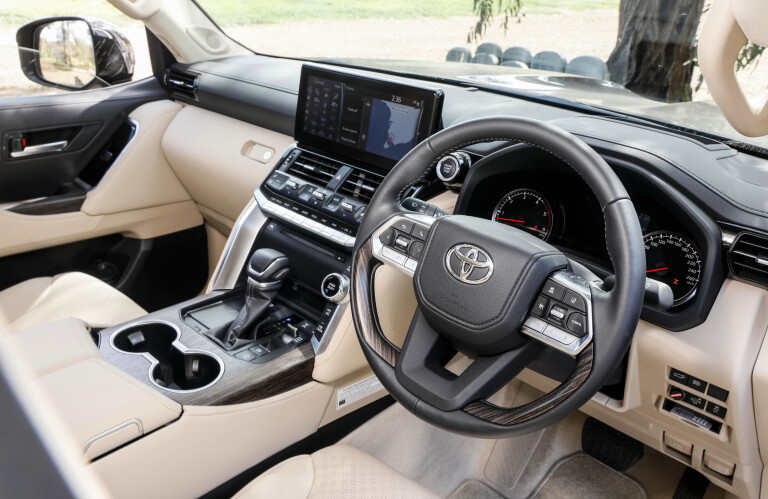
Seats in this Sahara model are leather trimmed and power adjustable, and both the front and second row seats offer heating and cooling functions. Of the six LC300 grades only the GXL, VX and Sahara models are offered with third-row seating for two passengers. These seats now fold flat in to the floor as opposed to up to the sides like they did in the 200, and in this Sahara they fold electronically. The third-row seats are big enough for adults on short trips, if they can squeeze there way in to the back, but are best suited to smaller people.
With the third row up and in position, there is very little space left behind it for cargo and this is somewhere that the Patrol has a big advantage.
PRACTICALITIES
THE fuel capacity has dropped from 138 litres in the LC200 to 110 in the 300, with 80 in the main tank and 30 litres in the sub-tank. It’s still substantial by modern standards, but every litre counts when you’re logging up the highway miles in a big wagon. It’s another area where the Nissan takes a win with its 140-litre tank.
The Sahara offers plenty of interior space for both passengers and cargo, although as mentioned, very little luggage space if you are using all the seats.

The Sahara wears 265/65R18 tyres which are becoming a more common size, so there should be plenty of options for more durable rubber than the standard highway tyres. Lower grades are fitted with 17s, so you should be able to opt to smaller wheels with taller sidewall tyres if desired, while the top of the range Sahara ZX wears 20-inch rims with low-profile tyres.
Toyota has a large range of genuine accessories for the 300, including the choice of steel or aluminium bullbars, nudge bars, an LED lightbar, roof racks, a Warn winch, underbody protection, rated front recovery points, a rear recovery hitch, and a raised air-intake snorkel which is standard on the GX model. As with all LandCruisers in the past, the aftermarket will soon offer plenty of accessory options for your LC300 to tailor it in any direction you like.
With a 3500kg tow rating and 650kg of payload, the Cruiser is built to haul, but owners of heavily equipped 300s will still need to be wary of GVM.
NISSAN PATROL Ti-L
POWERTRAIN & PERFORMANCE
LIKE the LandCruiser, the Patrol is only offered with a single powertrain but unlike the Toyota, its engine is petrol fuelled, not diesel. Plus it’s a V8 and a fine one at that. The 5.6-litres of double overhead cam V8 pumping out 298 of the sweetest kiloWatts and 560Nm of stonking torque is backed by a 7-speed auto and an on demand four-wheel drive system with high and low range.
Sure, the Australian 4x4 market is predominantly diesel-fuelled, but anyone who has ever driven one of these V8 Patrols will soon be weighing up the pros and cons of each fuel. The naturally-aspirated petrol V8 engine might not have the torque of a diesel but it has enough, and it certainly trumps most if not all diesels in power.
This characteristic gives the Patrol a more sporty feel to it, which allies perfectly with its more dynamic chassis when compared to the LandCruiser. The 7-speed automatic gives little to complain about other than our usual gripe with the way Nissan calibrates it’s autos to be so reluctant to let you manually shift down when off road.
The real con of this powertrain is fuel economy and that’s something you will get with any petrol when compared to an equivalent diesel. While it was a closer fuel misers fight against the TDV8 LC200, the improved efficiency of he 300’s V6 engine widens the gap. On test, it was 12.1L/100km from the Toyota to 17L/100km from the Nissan. That was a week of commuting and two days at the off-road proving ground, but the gap would narrow with more open highway miles on the vehicles.
ON ROAD RIDE & HANDLING
THE Patrol uses independent suspension both front and rear and while this might scare many an off-road enthusiast away, it shouldn’t. On road, it offers superior ride and handling with better control over bumps and through corners, be the road surface gravel or sealed. The LandCruiser can’t get near a Patrol in terms of dynamics.
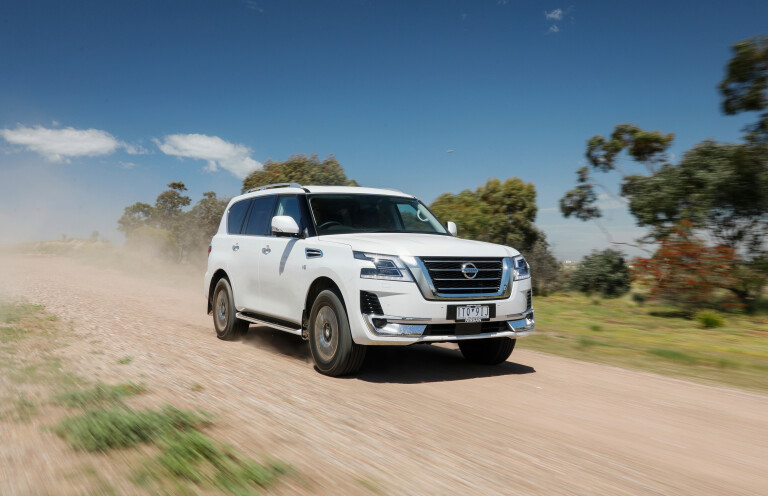
One of the key features that makes the Y62 handle to well is the Hydraulic Body Motion (HBMC) system that is standard on both Patrol models. Like Toyota’s e-KDSS, HBMC controls the amount of body roll depending on the speed of the vehicle and the terrain. But unlike e-KDSS, HBMC replaces the anti-roll bars and their action is done by the hydraulics.
HBMC works very well with the fully independent suspension allowing the big heavy Patrol to corner relatively flat on road while ‘releasing’ the wheels from the chassis to give more travel when off road. The only real disadvantage we see with HBMC is that it can hamper owners looking for bigger than normal suspension lifts.
OFF ROAD
THE Nissan loses some ground to the Toyota when you get off track, but not nearly as much as some would think. It has more ground clearance than the Cruiser and maintains that clearance well. The LC300 scraped its front end when descending our rutted hill, while the Patrol had no such issue. Nor did it have any issue climbing the hill, despite not having the rear wheel travel of the Cruiser and older electronics.
The Patrol’s ETC does get the job done, even if it’s not as refined as that in the Cruiser. It’s helped by a rear LSD which is also lockable when the going gets tough. While the Patrol doesn’t have anything like crawl control or fancy drive modes, it doesn’t need them either.
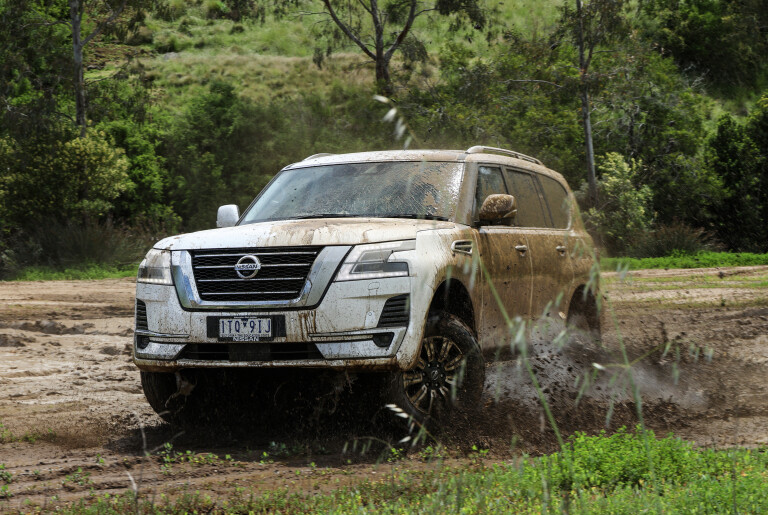
CABIN & ACCOMMODATION
FIRST impressions on jumping out of the Cruiser and in to the Patrol are that it is bigger and much simpler. And when I say simpler, I say it as a positive, not a negative. Yes, the Y62’s dash is showing its age, the chintzy chrome and faux woodgrain trim is tacky, the AV screen is smaller than the Cruiser and it doesn’t even have apple CarPlay, but as soon as you sit behind the wheel you know where everything is and how it operates. It’s not an interior that you have to ‘learn’ like so many of the more modern and more complex vehicles. The foot-release park brake is something from another era.
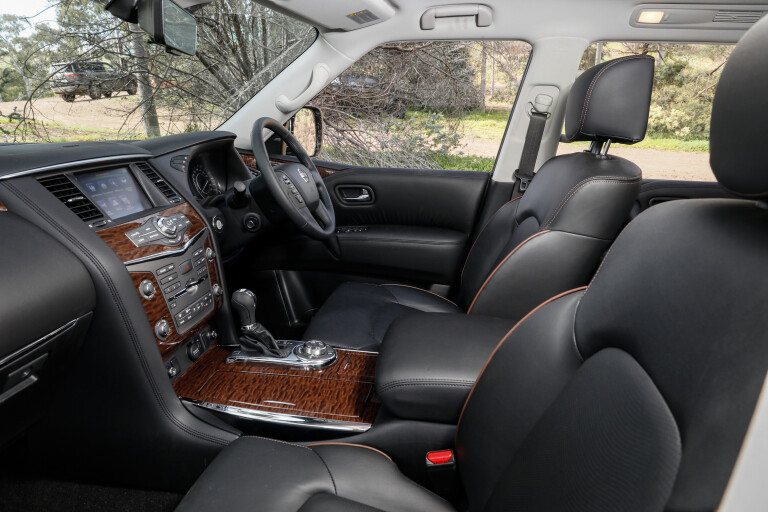
The Patrol interior does miss out on a few luxuries that the LandCruiser has as well: only the front seats are heated and cooled and power operated, the climate control is three-zone as opposed to four, and the rear entertainment system isn’t quite as complex, but it isn’t missing anything you really need. The Ti-L Patrol gets a power sunroof while the Sahara doesn’t, but then, the Cruiser gets a chilled centre console.
Where it does make up ground is in space and specifically behind the third-row seats. The Patrol is 185cm longer than the LC300 and it looks as though that’s all behind the third-row seats. We reckon there’s space enough for a 40L Engel behind there, while there’s barely any space behind the Cruiser’s third row for a couple of bags of ice. This difference also equates to the cargo space when the third-row seats are stowed away.
The Patrol can also be had as an eight-seater in Ti trim while this Ti-L is only offered with seven seats due to weight limits.
PRACTICALITIES
THE Patrol rolls on 265/70R18 tyres, so a bit taller than the standard tyres on the Cruiser and we’ve seen plenty of them rolling on 35s and bigger with relative ease.
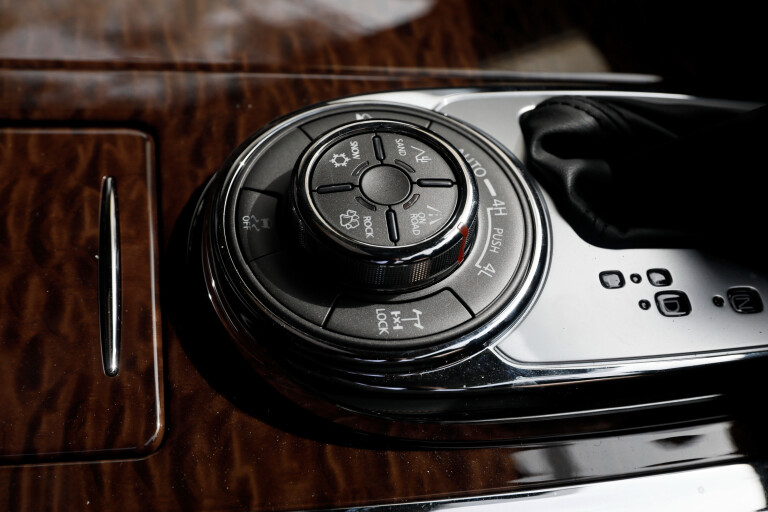
The aftermarket has been slow to develop gear for the Y62 over the years due to the relatively low numbers of them sold, so it can be limiting when doing a build. This is especially so if you have a latest update and the old front bars don’t fit, but you can pretty well get all you need for a serious touring build for one now.
The Ti-L’s payload is 639kg and all Patrols are rated to tow 3500kg.
VERDICT
WHEN you look at the sales numbers between the LandCruiser and Patrol over the past five years, you might think this is a one-horse race. Yes, the LC200 outsold the Y62 around five-to-one, but this has more to do with Australian drivers’ preference for diesel engines than anything else.
The Patrol has had a resurgence in popularity, certainly since Nissan Australia repositioned its price and range to bring both variants of Patrol in at less than $100K and introduced a few model upgrades and a major facelift.
Then again, as folks looked at real-world fuel consumption figures of the V8 diesel LandCruiser and found it wasn’t as efficient as it should be, and it started to have problems with the DPF system along with other Toyota diesel models. The simplicity of a naturally aspirated petrol V8 really started to have more appeal to more buyers. Add in the cost saving on initial purchase price and the Patrol started to look real enticing.

With the introduction of the LC300 and its V6 diesel and 10-speed transmission, we expect to see LandCruiser fuel numbers drop considerably once owners get in to them and start doing some real-world touring, but the new engine is every bit as complex, if not more so than the old V8. And the price of LandCruiser has gone up considerably with the new model. An LC200 Sahara was $123,500 not that long ago.
If you’re a diehard LandCruiser diesel fan then there will be no choice. The LC300 is a better driving vehicle than the 200, has more equipment, more features, improved torque over the V8, and it still feels very much like a LandCruiser to ride and drive in. Toyota has stuck to and refined its sales winning formula for the 300 and once supply issues are sorted, you’ll see them running off the showroom floor.
But if the added cost and the lack of a V8 engine has you shying away from the new Cruiser and considering a Patrol, you’ll be pleasantly surprised by the $36.5K saving on the purchase price, impressed by the on-road performance, and happy with the simple nature of the big Nissan.
The Patrol’s potent V8 engine and responsive chassis give it a sporting character, while the LC300 sticks to its heavier feeling, more floating dynamic that feels more tourer than sports wagon. Yes, the Patrol misses out on some tech and features, but it still has everything you need (except maybe Apple CarPlay) and while it uses more fuel, that $36K saving on price buys a lot of petrol or could give you a full vehicle fit-out at your favourite accessories store.
While both of these vehicles are suffering from supply issues as this is written, it would be a fully kitted Patrol in my driveway for my $135K if I had it.
TOYOTA LANDCRUISER 300 SAHARA SPECS
| ENGINE | Turbocharged V6 diesel |
|---|---|
| CAPACITY | 3346cc |
| MAX POWER | 227kW at 4000rpm |
| MAX TORQUE | 700Nm at 1600 to 2600rpm |
| GEARBOX | 10-speed auto |
| CRAWL RATIO | 42.62:1 |
| 4X4 SYSTEM | Full-time, dual range, locking centre diff |
| CONSTRUCTION | 5-door wagon on ladder chassis |
| FRONT SUSPENSION | Double wishbone IFS w/ coils. E-KDSS and variable shocks |
| REAR SUSPENSION | Live axle on links and coils. E-KDSS and variable shocks |
| TYRE/WHEEL | 265/65 / R18 |
| KERB WEIGHT | 2630kg |
| GVM | 3280kg |
| PAYLOAD | 650kg |
| TOWING CAPACITY | 3500kg |
| SEATING | 7 |
| FUEL TANK | 110L |
| ADR FUEL CLAIM | 8.9L/100km |
| ON-TEST FUEL USE | 12.1L/100km |
| DEPARTURE ANGLE | 25° |
| RAMPOVER ANGLE | 21° |
| APPROACH ANGLE | 32° |
| WADING DEPTH | 700mm |
| GROUND CLEARANCE | 235mm |
NISSAN PATROL TI-L SPECS
| ENGINE | DOHC petrol V8 |
|---|---|
| CAPACITY | 5552cc |
| MAX POWER | 298kW at 5800rpm |
| MAX TORQUE | 560Nm at 4000rpm |
| GEARBOX | 7-speed automatic |
| CRAWL RATIO | 44:1 |
| 4X4 SYSTEM | 2WD, on-demand 4WD and dual range locked 4WD |
| CONSTRUCTION | 5-door wagon on a separate chassis |
| FRONT SUSPENSION | IFS w/ double wishbones and HBMC |
| REAR SUSPENSION | IRS w/ double wishbones and HBMC |
| TYRE/WHEEL | 265/70 / R18 |
| KERB WEIGHT | 2861kg |
| GVM | 3500kg |
| PAYLOAD | 639kg |
| TOWING CAPACITY | 3500kg |
| GCM | 7000kg |
| SEATING | 7 |
| FUEL TANK | 140L |
| ADR FUEL CLAIM | 14.4L/100km |
| ON-TEST FUEL USE | 17.0L/100km |
| DEPARTURE ANGLE | 26.3° |
| APPROACH ANGLE | 28° |
| GROUND CLEARANCE | 273mm |



COMMENTS